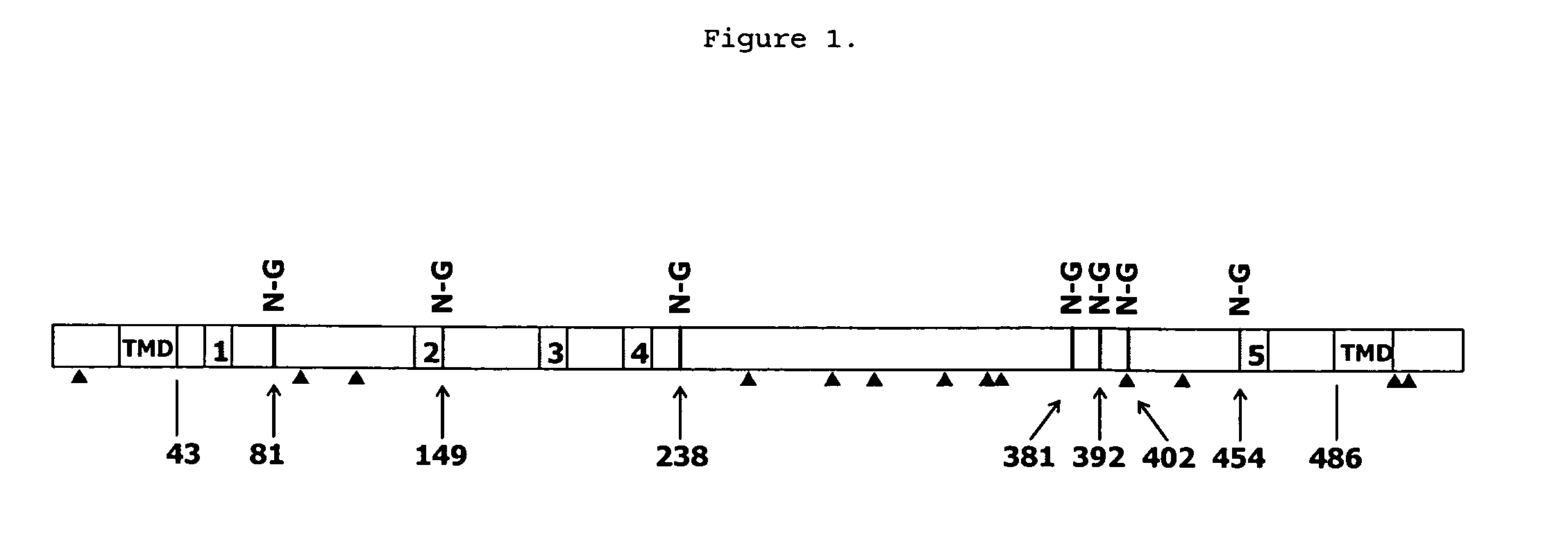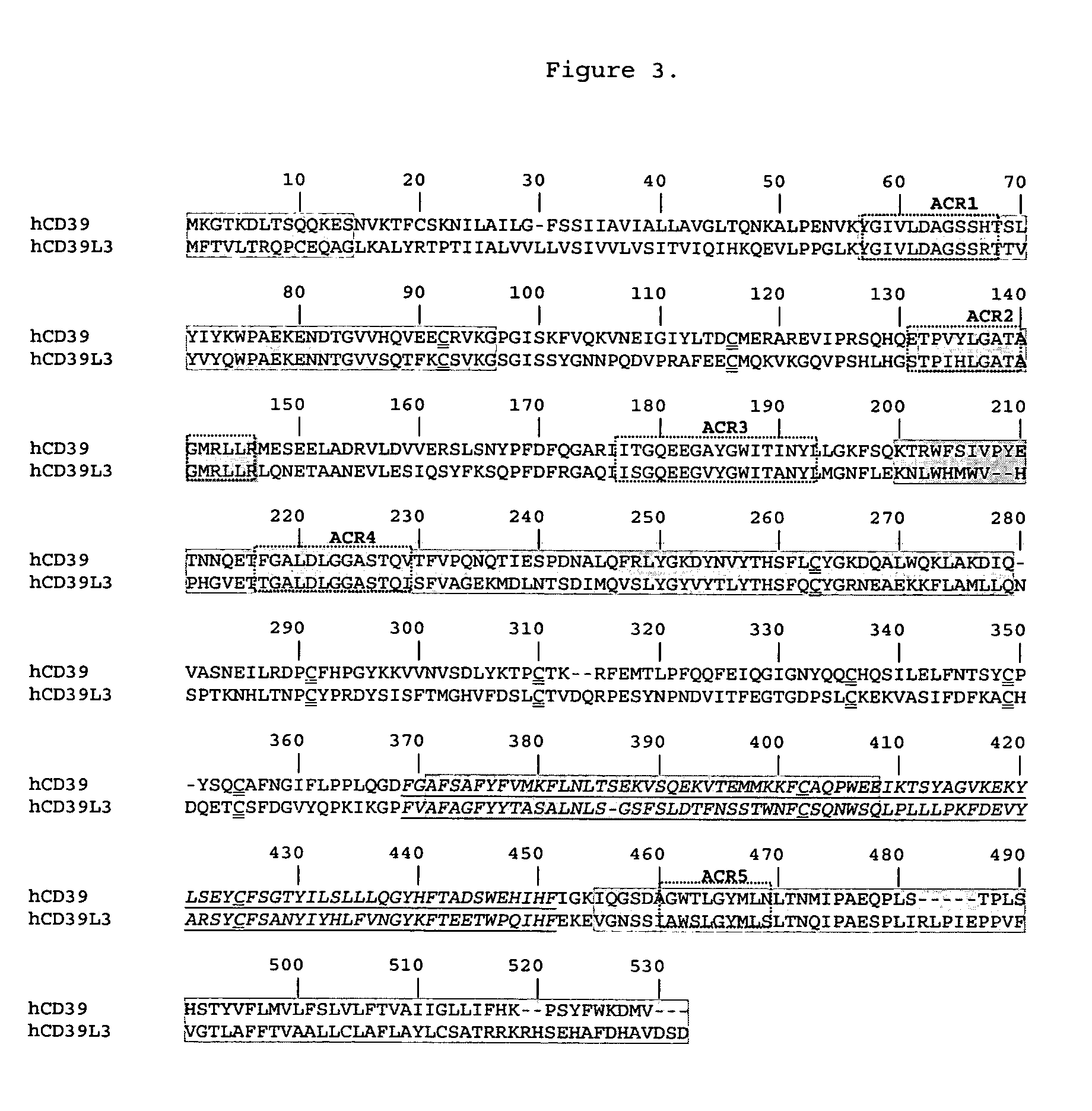Therapeutic use of soluble CD39L3
a technology of soluble cd39l3 and soluble cd39l3, which is applied in the direction of peptide/protein ingredients, peptide sources, instruments, etc., can solve the problems of limited therapeutic utility and bleeding complications of adpase, and achieve the effects of reducing unwanted related activities, reducing bleeding complications, and enhancing adpase activity
- Summary
- Abstract
- Description
- Claims
- Application Information
AI Technical Summary
Benefits of technology
Problems solved by technology
Method used
Image
Examples
example 1
Identification of CD39L3 as an Isozyme of CD39
[0093]CD39 has been established as a key thromboregulator and essential for regulating normal blood flow. However, northern blot analysis on multiple human tissues demonstrated negligible expression of CD39 in brain. The brain is a blood vessel rich organ that requires thromboregulation. Since CD39 is a key thromboregulator and it is not expressed in sufficient quantities in human brain tissue an isoenzyme of CD39 should likely be present. Based upon the expression patterns of the CD39 family in human brain tissue, CD39L3 was highly expressed. Protein informatics analysis for CD39 and CD39L3 demonstrated the following: (1) ATPase and ADPase activities were similar in terms of initial velocities (Smith and Kirley, Biochemica et Biophysica Acta, (1998) 1386:65-78; Gayle, R. B. III, et al., J. Clin Invest. (1998) 101:1851-1859.) (2) Protein hydrophobicity profiles of CD39 and CD39L3 were similar (Chadwick and Frischauf, Genomics (1998) 50:3...
example 2
Cloning of CD39L3
[0094]CD39L3 has been determined to be an isozyme of CD39 that is preferable expressed in human brain tissue. Chadwick and Frischauf (Genomics (1998) 50:357-367) have studied the tissue distribution of several CD39 family members including CD39L3. Based on their observations it is clear that CD39L3 is predominately expressed in Human brain and pancreas tissues and represent preferred source material for cloning CD39L3. Other tissue sources useful for cloning CD39L3 include but are not limited to placenta, spleen, prostate, ovary, small intestine and colon.
[0095]Cloning of CD39L3 can be accomplished by numerous methods available to one skilled in the art. For example, total RNA or poly-A RNA can be purified from source tissues mentioned supra and used as a template for gene specific RT-PCR. Additionally, pre-made cDNA libraries can be purchased from commercial sources and PCR can be employed to amplify the CD39L3 cDNA directly. Still further, synthetic oligos can be ...
example 3
Design and Cloning of a Soluble Form of CD39L3
[0098]The protein sequence of CD39L3 was analyzed by Swiss-Prot (Bairoch, A. & Apweiler, R., Nucleic Acids Res (2000) 28:45-48). The analysis indicated that CD39L3 has a transmembrane domain at both the N- and C-termini (FIG. 1), for example 23 to 43 in N-terminus and 486 to 506 in C-terminus. Also seven potential N-glycosylation sites are identified. Based on the analysis, a soluble form of CD39L3 was designed by removing the N-terminal 44 amino acids and the C-terminal 43 amino acids.
[0099]The soluble form of CD39L3 was obtained by PCR using the primers CD39L3 5′ (SEQ ID NO:2) and L3-8 (SEQ ID NO:12). The PCR product was sequenced and subcloned in pGEM-T Easy resulting in plasmid pAPT 7901 (FIG. 8). The complete truncated CD39L3 was obtained by operably combining the coding regions of CD39L3 from plasmids pAPT7901 (digested Not I / SnaBI) and pAPT7863 (digested SnaBI / NotI) resulting in plasmid pAPT7937 (FIG. 9). The nucleotide sequence o...
PUM
| Property | Measurement | Unit |
|---|---|---|
| Fraction | aaaaa | aaaaa |
| Fraction | aaaaa | aaaaa |
| Biological properties | aaaaa | aaaaa |
Abstract
Description
Claims
Application Information
 Login to View More
Login to View More - R&D
- Intellectual Property
- Life Sciences
- Materials
- Tech Scout
- Unparalleled Data Quality
- Higher Quality Content
- 60% Fewer Hallucinations
Browse by: Latest US Patents, China's latest patents, Technical Efficacy Thesaurus, Application Domain, Technology Topic, Popular Technical Reports.
© 2025 PatSnap. All rights reserved.Legal|Privacy policy|Modern Slavery Act Transparency Statement|Sitemap|About US| Contact US: help@patsnap.com



